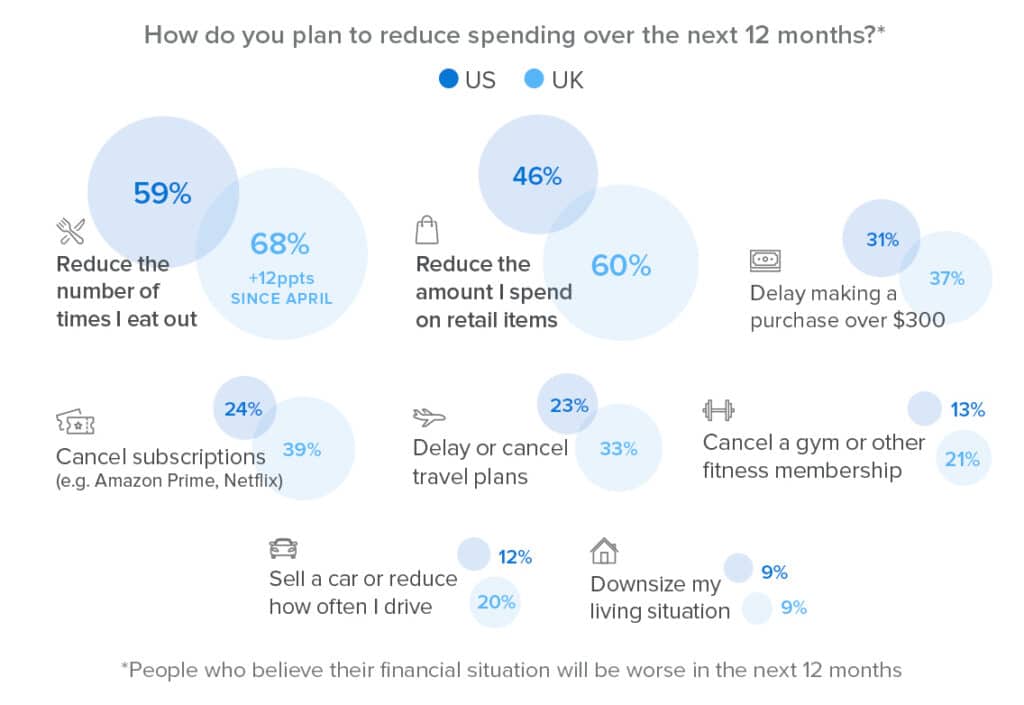The Impact of Inflation on Consumers: Driving Value with Strong Customer Experiences
Published on Sep 07, 2022

Today’s economic uncertainties have brands across industries struggling to manage the impact of inflation on their business, facing tough questions like: Should we raise prices? Cut staff? How can we continue to prioritize the customer experience? Or drive employee engagement?
To help inform some of these decisions and better understand the impact of inflation on consumers, we’ll first take a look at the current state of consumer spending habits—where they’re cutting back and where they’re planning to spend more. Next, we’ll do a deep dive on what “value” really means to customers—is it simply all about cost or are other factors at play? And finally, we’ll provide a list of best practices brands should implement to drive value, engage field teams, and deliver stronger customer experiences.

How the global economy is impacting consumer spend
Consumers are worried about finances—and it’s impacting their spending habits
Let’s get the bad news out of the way: SMG research on consumer behavior trends shows 63% of UK respondents believe their finances will take a hit over the next year (a 9-ppt increase from April 2022). US consumers are slightly more optimistic, with 1 in 4 expecting their finances to worsen.
Nearly 70% of UK consumers and nearly 60% of US consumers said that means fewer visits to restaurants. And almost half of US respondents and 60% of UK respondents said it will entail cutting back on shopping at non-essential retailers. Other behaviors to note: 39% of UK consumers plan to cancel subscriptions (e.g., Amazon Prime, Netflix) and 31% of US consumers plan to delay purchases over $300.

Will this behavior stick for a bit? Probably. Are these changes impacting your business? Very likely. Is there anything you can do about it? Absolutely.
Brands can win customer loyalty by delivering value-forward experiences
Yes, the inflation is impacting consumer behavior causing customers to be more financially conscientious and pay better attention to how they allocate their spending. But they are still spending. And the key to winning (+ keeping) their business relies heavily on one important factor: the value you provide them.
Consumers want more bang for their buck. But that doesn’t always mean they’re looking for the cheapest option. High value isn’t all about being less expensive—it’s about providing a differentiated product or service that customers feel is worth the price they paid.

Here’s an example: When a customer chooses to eat at a restaurant, they’ve already committed to spending money there. They’ve likely either done some research on the place or have been there before and have a general idea of food costs. While they may raise their eyebrows at some high-ticket items or notice a recent increase in menu pricing, they have committed to spending money at this establishment and so they place their order.
Unfortunately for this customer, their dining experience wasn’t at all satisfying. Their order took forever to arrive. The music in the restaurant was too loud. Their server was a bit rude. The food tasted fine, but when their check arrives, suddenly the cost of their meal means everything. “What a waste of money,” they think (and then post all over social media).
Is their frustration directly related to the price of their meal? No. They knew what they were spending when they ordered it. But when their overall experience went to hell in a breadbasket, the value of that steak plummeted—likely costing the restaurant any future business with that customer (or their 100K followers).
What if things would have gone differently for that customer? Maybe their server is more attentive and apologizes for the delay, providing more timely updates on their order. Or the front-of-house manager notices Cardi B is still blaring from pre-shift setup and switches the music to a more mellow playlist. None of these things have any impact on the cost of that customer’s food. But they have everything to do with that customer’s perceived value of their overall experience.
High-value customer experiences start with an engaged and empowered field team
There’s no denying the cost of goods has increased exponentially over the last year. There’s also no denying that most of this is out of your control and at the mercy of a damaged supply chain.
Ready for some good news?
This is also true for your competitors.
And so, as we all weather this inflation together, the brands that will come out on top won’t be the ones that somehow avoided higher prices—it’ll be the ones that provided customers with value.
And this starts with your front-line employees.
Before we dig into the specific ways field teams can make or break your value offering, let’s take a step back and look at the connection between engaged employees, satisfied customers, and better business outcomes. This progression (and the philosophy SMG was founded on) is called The Service Profit Chain, which demonstrates how engaged employees are more loyal, helping create highly satisfied and loyal customers—and highly satisfied, loyal customers lead directly to growth in sales and profits.
The first step in creating a value-forward experience for your customers is to prioritize your employee engagement efforts and answer these questions:
- What job differentiators are we offering to help attract and retain top talent?
- Are we providing employees with rewarding and purposeful work?
- How efficiently are we implementing employee feedback?
But don’t try to answer these questions on your own. Collecting feedback directly from associates and using that data to influence change across the organization is one of the best ways to set the stage for better customer experiences (especially during times of a challenging labor market). When your employees see their feedback being translated into tangible change, they feel validated, respected, and satisfied—and your customers can see it, too.
Now let’s get into some specific best practices you can implement to help drive employee engagement.
Recognize employees for their achievements
Finding innovative ways to provide exceptional service is the entire reason you’re investing in the employee experience—so when employees help you win with customers, it’s important to recognize their achievements and celebrate as a team. There are several ways you can track and celebrate program wins, including:
- Using celebration alerts when customers recognize an employee for exceptional service
- Sending monthly communications from executives to call out top performers
- Incentivizing continuous improvement by rewarding teams that achieve the goals you set
Bottom line: When you’re trying to keep employees engaged, don’t just reward them—create a workplace that makes work rewarding.
Tailor reporting tools to specific roles
It’s hard to formulate and execute an effective game plan if your team members don’t understand their positions. To be efficient, your CX program has to provide a comprehensive suite of tools uniquely fitted to each level and role, whether it’s:
- Location-level reporting dashboards that identify Areas for Focus
- Mobile apps for mid managers traveling between locations
- Powerful report-builders to help corporate users dig for new insights
Be sure to communicate how different user groups can use their respective tools to drive continuous improvement at every location. Your CX program is a corporate initiative, but its success hinges on system-wide adoption and execution. Check in regularly to make sure managers are coaching low performers, sharing best practices, and doing everything they can to keep scores trending up.
Act on insights immediately for meaningful change
What’s worse than not asking your employees for feedback? Asking and doing nothing about it.
Acting on results at all levels of the organization is key to improving employee engagement. Managers who communicate results, take steps to improve engagement, and recognize associates tend to have the most improvement.
Following through on feedback doesn’t just send a positive message to employees—it also creates a proactive approach to solving issues before they become larger, systemic problems. Employee insights help answer critical business questions (e.g., What are associates telling us to improve? Which locations are seeing high turnover?), so you can move on action items that will have the most impact.
Drive value, engage employees, and deliver better customer experiences
The economic struggles ushered in by the current inflation are being felt by everyone—your customers, your employees, and your company as a whole. But through this challenge comes an opportunity to not only be a brand that provides customers with the value they are seeking, but to be an organization that creates a valuable experience for its employees. These two things are not unrelated and brands that prioritize both will be the ones to come out of this challenging economy on top.
If you enjoyed the content in this blog and want to get a better understanding of how today’s economy is impacting consumers’ spending habits, download the executive brief.
Related articles

Customer experience strategy best practices to keep up with 2023 CX trends
With the right customer experience strategy best practices, brands can best prepare for the evolving customer experience trends of 2023.

Tailor CX reporting tools to specific roles for bigger impact
When it comes to the customer experience, there are no small roles within your organization—everyone makes an impact. By getting your entire team on board and in tune with your CX measurement strategy

Optimize your digital experience management strategy
Here are the 3 most common pitfalls we help clients avoid while prioritizing their digital experience management (XM) strategies...